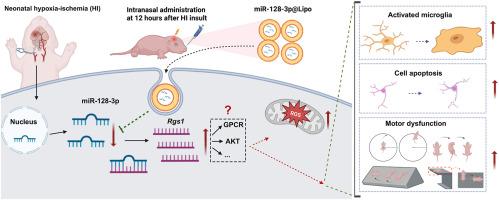脂质体负载miR-128-3p通过靶向新生小鼠Rgs1在缺氧缺血损伤中发挥神经保护作用。
IF 4.7
3区 医学
Q1 PHARMACOLOGY & PHARMACY
引用次数: 0
摘要
严重缺氧缺血(HI)引起的围产期脑损伤是全球范围内新生儿死亡率和长期慢性疾病高发的重要原因,其临床治疗仍局限于治疗性低温治疗,疗效有限。MiRNA-128是一种在中枢神经系统中高度表达的富含大脑的微编码RNA。在这项研究中,我们发现,在幼鼠HI损伤后,同侧皮质组织中miR-128-3p (GSE213067中预测下调的miRNA)的表达显著降低。然后,我们成功构建了分散良好,大小均匀的脂质体封装的miR-128-3p纳米颗粒(miR-128-3p@Lipo),具有良好的稳定性和生物安全性。此外,使用miR-128-3p@Lipo纳米颗粒递送系统可以通过无创的鼻内途径同时将miR-128-3p递送到神经元。通过miR-128-3p@Lipo上调同侧皮质组织中miR-128-3p水平可显著改善新生小鼠HI损伤后脑梗死、细胞凋亡、神经炎症和活性氧水平,促进神经功能恢复。进一步的机制探索表明,miR-128-3p可能通过抑制下游靶基因调控G蛋白信号传导1 (Rgs1)的表达来发挥神经保护作用。这项研究表明,mirna在减轻新生儿小鼠HI脑损伤方面具有治疗潜力。本文章由计算机程序翻译,如有差异,请以英文原文为准。

Liposomes-loaded miR-128-3p exert neuroprotective effects in hypoxia-ischemia injury by targeting Rgs1 in neonatal mice
Perinatal brain injury due to severe hypoxia-ischemia (HI) is a significant cause of neonatal mortality and high prevalence of long-term chronic disease on a global scale, whose clinical treatment is still limited to therapeutic hypothermia with limited efficacy. MiRNA-128 is a brain-enriched microcoding RNA that is highly expressed in the central nervous system. In this study, we found that miR-128-3p expression, a predicted down-regulated microRNA (miRNA) in GSE213067, was significantly reduced in ipsilateral cortical tissues after HI injury in pups. Then we successfully constructed a well-dispersed and uniformly sized liposome-encapsulated miR-128-3p nanoparticle (miR-128-3p@Lipo), with exhibited good stability and biosafety. Moreover, the use of a miR-128-3p@Lipo nanoparticle delivery system could simultaneously deliver miR-128-3p to neuron via a non-invasive intranasal route. Up-regulation of miR-128-3p levels in the ipsilateral cortical tissues via miR-128-3p@Lipo significantly ameliorated cerebral infarcts, apoptosis, neuroinflammation, and reactive oxygen species levels and facilitated the recovery of neurological function after HI injury in neonatal mice. Further mechanistic exploration revealed that miR-128-3p may exert neuroprotective effects by inhibiting the expression of the downstream target gene Regulating G protein signaling 1 (Rgs1). This work suggests that miRNAs offer a therapeutic potential to mitigate HI brain damage in neonatal mice.
求助全文
通过发布文献求助,成功后即可免费获取论文全文。
去求助
来源期刊
CiteScore
9.00
自引率
0.00%
发文量
572
审稿时长
34 days
期刊介绍:
The European Journal of Pharmacology publishes research papers covering all aspects of experimental pharmacology with focus on the mechanism of action of structurally identified compounds affecting biological systems.
The scope includes:
Behavioural pharmacology
Neuropharmacology and analgesia
Cardiovascular pharmacology
Pulmonary, gastrointestinal and urogenital pharmacology
Endocrine pharmacology
Immunopharmacology and inflammation
Molecular and cellular pharmacology
Regenerative pharmacology
Biologicals and biotherapeutics
Translational pharmacology
Nutriceutical pharmacology.

 求助内容:
求助内容: 应助结果提醒方式:
应助结果提醒方式:


